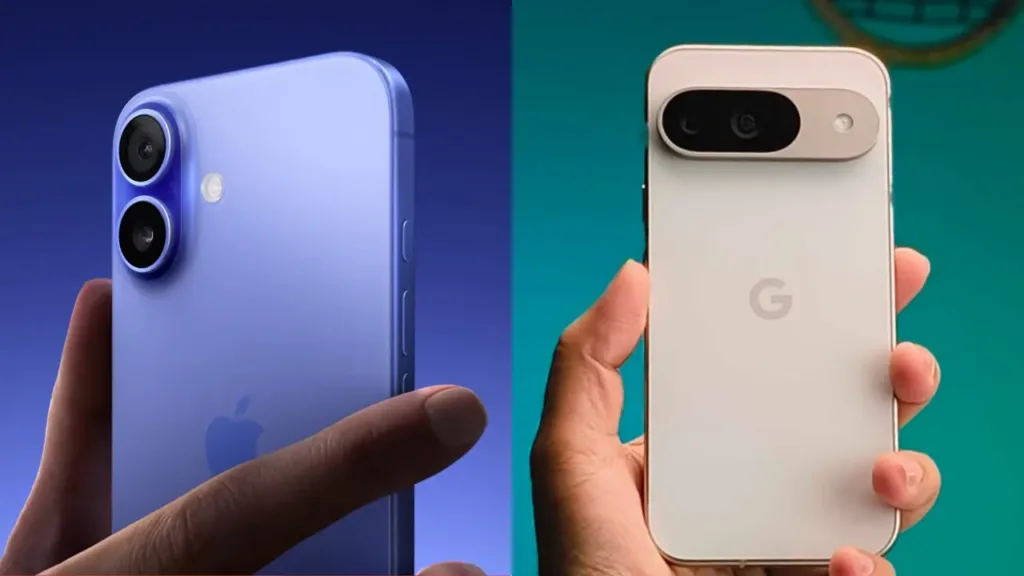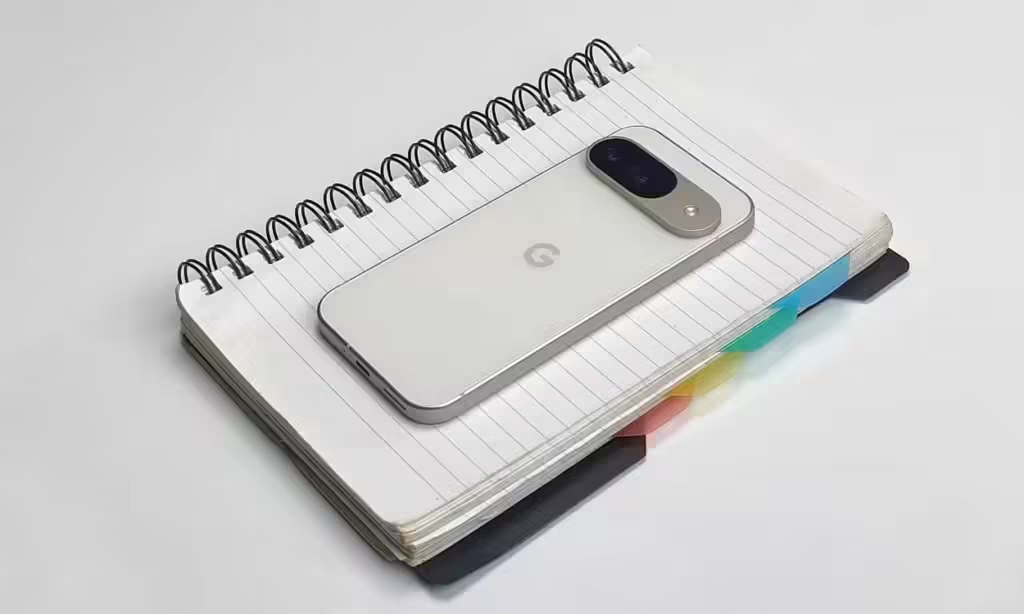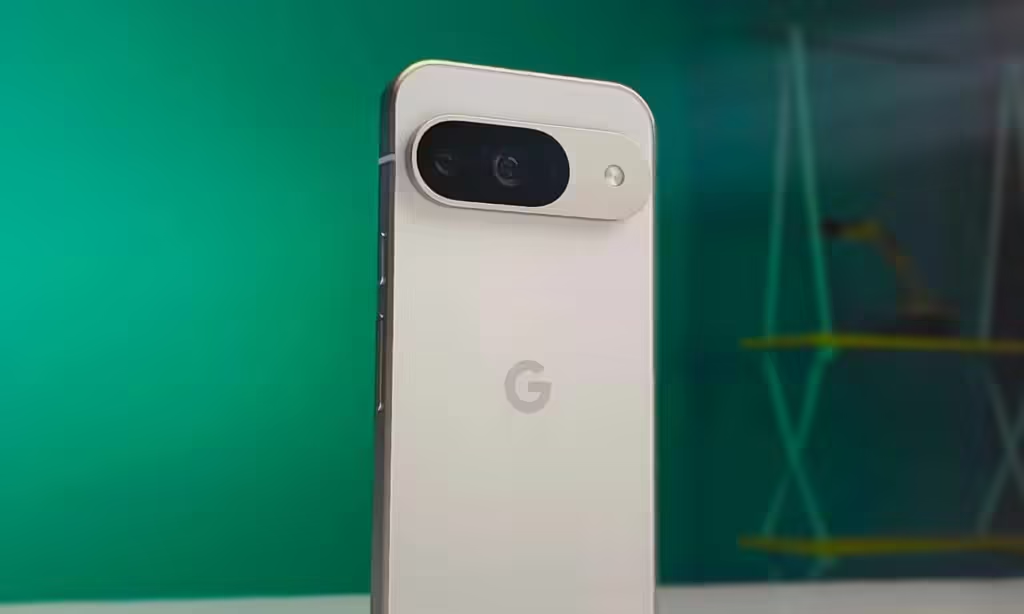
The iPhone 16 has arrived, featuring the new Apple A18 chip and poised to take on the competition. On the other hand, the Pixel 9 recently launched with its Tensor G4 chip, directly competing with the latest iPhone in the compact flagship arena. If you’re in the market for the top compact flagships, which one should you choose? Join us in this detailed comparison as we pit the iPhone 16 against the Pixel 9.
iPhone 16 vs Pixel 9: Specifications

Design and Build

Apple sticks with familiar designs, and the iPhone 16 is no exception. It retains the same dimensions, build quality, and premium feel as its predecessors. The phone features a glass back, aluminum frame, and an IP68 rating for water and dust resistance.
Despite its other features, the iPhone 16 still lacks any rear protection. In contrast, the Pixel 9 includes Gorilla Glass Victus 2 on its back panel. Both phones have an aluminum frame and an IP68 rating.
The Pixel 9 represents a departure from its predecessor, as I noted in my review. It’s slightly larger and bulkier, weighing in at 198 grams, compared to the iPhone 16’s lighter 171 grams. If you prefer a lighter phone, the iPhone 16 might be more to your liking. On the other hand, if you favor a more substantial feel, the Pixel 9’s heft might be more appealing.


This year’s Pixel 9 stands out with its distinctive oval camera module design, giving it a unique personality. In contrast, the iPhone 16 sticks to a minimalistic vertical camera module design reminiscent of the iPhone X. While I prefer this over the square module seen on recent iPhones, it doesn’t compare to the Pixel 9’s more striking design.
Not only does the Pixel 9’s camera module look better, but it also offers better stability on a desk. For someone like me, who spends a lot of time typing at a desk, the slight elevation and lack of wobble are incredibly convenient.
The iPhone 16 excels in button placement, with the power button and volume rockers evenly distributed on either side of the frame, plus a new Capture Button. In contrast, the Pixel 9 groups all its buttons on the right side, which I find less ideal.
Both phones, however, offer a range of color options. The iPhone 16 comes in five colors this year, including Ultramarine, Teal, and Pink, alongside the classic White and Black. The Pixel 9 comes in Obsidian, Porcelain, Peony, and Wintergreen.
While the iPhone 16 doesn’t offer much of a design evolution, the Pixel 9 provides a refreshingly aesthetic update and clearly stands out as the more visually distinctive choice.
Display

The iPhone 16 boasts a 6.1-inch Super Retina XDR OLED display with a 60Hz refresh rate. In contrast, the Pixel 9 offers a larger 6.3-inch AMOLED display with a smoother 120Hz refresh rate. Both displays are FHD+, but the Pixel 9’s higher refresh rate provides a noticeable advantage.
Additionally, the Pixel 9 is protected by Gorilla Glass Victus 2 on both the front and rear panels, whereas the iPhone 16 uses Ceramic Shield. I’ve been using the Pixel 9 extensively without a tempered glass protector and, despite keeping it with other phones in my bag, it has remained free of scratches.
According to Apple, the Ceramic Shield on the iPhone 16 is 50% tougher than the first-generation version, promising improved scratch and crack resistance.
In terms of peak brightness, the iPhone 16 offers 1600 nits, while the Pixel 9 boasts a much brighter 2700 nits. This means the Pixel 9 offers superior visibility in both outdoor and indoor environments. On the other hand, the iPhone 16 has a higher pixel density at 460 PPI compared to the Pixel 9’s 422 PPI, which should result in a sharper display.
Overall, though, the Pixel 9’s display stands out as the superior option.
Performance

Apple has consistently led the performance race with its powerful chipsets, and the iPhone 16 continues this trend with a significant upgrade from the iPhone 15’s A16 Bionic to the new A18 chip. This chip features a 6-core CPU and a 5-core GPU, delivering impressive power for all tasks.
According to Apple, the new 5-core “desktop-class” GPU is 35% more energy efficient and 40% faster than the A16 Bionic. The CPU, which includes 2 performance cores and 4 efficiency cores, is 30% faster than its predecessor. Additionally, the A18 chip introduces a new neural engine with 17% more memory bandwidth, providing enhanced capabilities for Apple’s advanced AI features.

Google’s Tensor series of chipsets have traditionally fallen short in synthetic benchmarks, and this year’s Tensor G4 is no exception. Despite its 8-core setup (1 prime core, 3 performance cores, and 4 efficiency cores), it may not score high in benchmarks, but it still provides solid day-to-day performance. Throughout my use, I didn’t experience any stuttering or lag, even with multiple apps running in the background.
However, the Apple A18 chip is significantly more powerful and will offer a more premium experience compared to the Pixel 9’s Tensor G4.
Software Experience and AI Features

The iPhone 16 comes with iOS 18 right out of the box, and it certainly accelerates the Androidification of iPhones. With enhancements like home screen personalization, lock screen customizations, RCS in Messages, and a completely redesigned Control Center, iOS 18 revitalizes the iPhone experience. Plus, the Shortcuts app introduces a vast array of features that, as an Android user, I’ve always envied!
Conversely, the Pixel 9’s Android 14-based Pixel UI is ahead in terms of both features and aesthetics. Android users have long enjoyed the flexibility of placing apps anywhere on the home screen and a dedicated Game Mode. Additionally, Pixel’s haptic feedback is solid and more refined compared to that of the iPhone.

When it comes to AI features, the Pixel 9 is notably more polished and advanced. Google has been refining its Gemini AI models for a while, resulting in a more comprehensive and sophisticated AI experience. In contrast, Apple Intelligence on the iPhone 16 is still in its early stages and has a way to go before it matches the competition.
Currently, while features like Writing Tools and phone call recording are useful, the Clean-Up tool in the Photos app falls short of expectations. Additionally, the web page summarization feature is quite basic and is something that most other Android phones already offer.
In comparison, the Pixel 9 offers a range of innovative AI features such as Pixel Screenshots, Add Me, Pixel Studio, Reimagine in Magic Editor, Gemini Live, and Auto Frame, among others.
While software experience is ultimately subjective, the Pixel 9’s smooth performance combined with its fast refresh rate provides a highly satisfying user experience. Additionally, the Pixel 9 is supported by 7 years of software updates, bringing it very close to the level of support typically offered by iPhones.
Cameras

The iPhone 16 retains the same camera setup as its predecessor, with a 48MP primary sensor and a 12MP ultra-wide sensor. This year, the ultra-wide sensor adds autofocus, a feature previously reserved for the Pro models.
Notably, the new ultra-wide sensor also functions as a macro lens, a feature that was once exclusive to the higher-end models. This addition is a welcome enhancement. The front camera continues with the same 10.5MP selfie shooter.

The Pixel 9 continues with the 50MP Octa PD primary sensor from the Pixel 8 but upgrades to a superior 48MP ultra-wide sensor, compared to the previous 12MP version. The front camera remains unchanged, featuring the same 10.5MP selfie shooter.
On paper, aside from the increased megapixels in the Pixel 9’s ultra-wide sensor, there isn’t a substantial difference between the two phones. A side-by-side comparison will be necessary to determine the better performer. I’ll provide a detailed camera comparison as soon as I have the iPhone 16 in hand.
In the meantime, the iPhone 16’s new capture button is likely to enhance the camera experience significantly. A light touch minimizes the camera app’s UI elements, focusing attention on the subject. Additionally, swiping sideways allows you to zoom in or out within your frame.
Battery and Charging
Apple continues its trend of increasing battery size with the iPhone 16, although the exact battery capacity is not disclosed. As always, we’ll have to rely on Apple’s claims for now.
In contrast, the Pixel 9 features a 4,700mAh battery, which is larger than the iPhone 16’s capacity. However, iOS is generally more power-efficient than Android and handles background activity better. As a result, despite the iPhone 16’s smaller battery, it is expected to provide a full day of usage just like the Pixel 9.
Charging speeds have long been a weak point for iPhones, and the iPhone 16 doesn’t improve in this area. It still supports a maximum of around 20W charging, taking about 1.5 hours to fully charge the phone. In contrast, the Pixel 9 offers faster 27W charging, despite its larger battery, providing quicker top-ups.
Interestingly, the iPhone 16 now supports 25W MagSafe charging speeds, which is a notable improvement. On the other hand, the Pixel 9 is limited to 12W wireless charging.
Which is the Better Standard Model?


The age-old Android vs. iOS debate seems less relevant now. What really matters is the value you get for your money. Neither the iPhone 16 nor the Pixel 9 offers the latest hardware features like LTPO displays or faster charging, and the iPhone 16 still has a 60Hz refresh rate.
If performance and the iPhone’s renowned videography are your top priorities, the iPhone 16 is a strong choice. Conversely, if you’re seeking an exceptional multimedia experience, the Pixel 9 stands out as the better option.
When it comes to software experience, neither phone clearly outshines the other, as each has its own strengths and weaknesses. If you value a robust app ecosystem, the iPhone remains unmatched. Additionally, if you’re already embedded in the Apple ecosystem, switching to the Pixel 9 may not be the best choice.
The Pixel 9 excels with its advanced AI features and a stylish, modern design. In the end, your choice will depend on your priorities and preferences. In the end, both phones are outstanding compact devices that can handle a wide range of tasks effortlessly.




